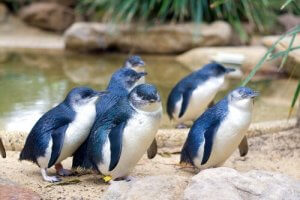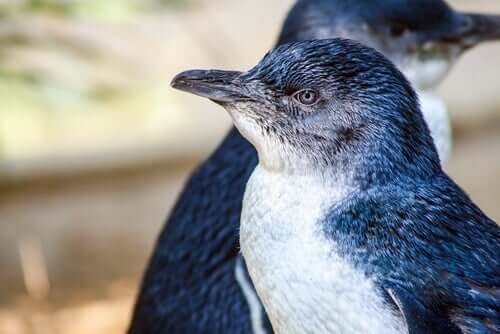The Little Penguin: The Smallest of Its Kind


Written and verified by biochemistry Luz Eduviges Thomas-Romero
The little penguin is a fascinating species of penguin that inhabits the coast of New Zealand. Also known as the little blue penguin and fairy penguin, it’s the smallest breed in the Spheniscidae family.
Penguins are flightless birds. Unlike birds that actually can fly, penguins have solid bones, which helps them swim more easily. This specific breed of penguin is usually around 1 foot tall in adulthood, and weighs a little over 2 pounds.
Penguins are mostly nocturnal animals. In some cases, you might even see them near human areas. Despite their small size, little penguins tend to make a lot of noise at night, when they’re most active.

As you’ve probably already guessed, this species is blue. Some of them are closer to black, though most of them are closer to gray. Like other members of their species, these penguins have white abdomens.
Like many other animals, the little penguin is sexually dimorphous. In this case, the males are slightly bigger than the females. Male beaks are generally also darker and wider.
They eat about 25% of their entire body weight in fish every day. They’re extremely fast in the water thanks to their small size and weight, and this makes them great hunters.
Habitat and distribution of the little penguin
They live mostly on North, South, and Stewart Island in New Zealand. But you might also see them on the Three Kings Islands, which are uninhabited by humans. You might also see this breed on the southeastern coasts of Australia. The locals there call it the “fairy penguin,” and it’s even part of their folklore!
They generally dig their nests in sandbanks or near large rocks. If possible, they’ll try to build their nests in places where they’ll be protected by thick vegetation. The current figures say that there are at least 32,000 of this breed living in New Zealand alone.

They also spend most of their lives in the water, swimming around. Of all the different breeds of penguin, they’re one of the best at aquatic maneuvering. They can spend several days in the water before they need to go back to the coast.
Reproduction
Depending on the time of year, this breed could go an entire month without returning to land. This means that they don’t spend much time around their nests. The main time you’ll see them there is during the mating season. But, unlike most other birds, they don’t keep a single partner for their whole lives. A female can also lay one or two eggs each time.
Both parents will take turns incubating the eggs, while the other goes out to hunt and swim. The incubation period lasts about 35 days. Once the egg hatches, they’ll feed the chick by regurgitating food into its mouth, like other birds. A baby is considered an adult at 7-11 weeks after its birth. By then, it should be able to hunt and swim by itself.
The little penguin is a fascinating species of penguin that inhabits the coast of New Zealand. Also known as the little blue penguin and fairy penguin, it’s the smallest breed in the Spheniscidae family.
Penguins are flightless birds. Unlike birds that actually can fly, penguins have solid bones, which helps them swim more easily. This specific breed of penguin is usually around 1 foot tall in adulthood, and weighs a little over 2 pounds.
Penguins are mostly nocturnal animals. In some cases, you might even see them near human areas. Despite their small size, little penguins tend to make a lot of noise at night, when they’re most active.

As you’ve probably already guessed, this species is blue. Some of them are closer to black, though most of them are closer to gray. Like other members of their species, these penguins have white abdomens.
Like many other animals, the little penguin is sexually dimorphous. In this case, the males are slightly bigger than the females. Male beaks are generally also darker and wider.
They eat about 25% of their entire body weight in fish every day. They’re extremely fast in the water thanks to their small size and weight, and this makes them great hunters.
Habitat and distribution of the little penguin
They live mostly on North, South, and Stewart Island in New Zealand. But you might also see them on the Three Kings Islands, which are uninhabited by humans. You might also see this breed on the southeastern coasts of Australia. The locals there call it the “fairy penguin,” and it’s even part of their folklore!
They generally dig their nests in sandbanks or near large rocks. If possible, they’ll try to build their nests in places where they’ll be protected by thick vegetation. The current figures say that there are at least 32,000 of this breed living in New Zealand alone.

They also spend most of their lives in the water, swimming around. Of all the different breeds of penguin, they’re one of the best at aquatic maneuvering. They can spend several days in the water before they need to go back to the coast.
Reproduction
Depending on the time of year, this breed could go an entire month without returning to land. This means that they don’t spend much time around their nests. The main time you’ll see them there is during the mating season. But, unlike most other birds, they don’t keep a single partner for their whole lives. A female can also lay one or two eggs each time.
Both parents will take turns incubating the eggs, while the other goes out to hunt and swim. The incubation period lasts about 35 days. Once the egg hatches, they’ll feed the chick by regurgitating food into its mouth, like other birds. A baby is considered an adult at 7-11 weeks after its birth. By then, it should be able to hunt and swim by itself.
All cited sources were thoroughly reviewed by our team to ensure their quality, reliability, currency, and validity. The bibliography of this article was considered reliable and of academic or scientific accuracy.
- Gales, R.; Green, B. (1990) The Annual Energetics Cycle of Little Penguins (Eudyptula Minor). Ecology: Ecological Society of America. Volume 71, Issue 6. Pp. 2297-2312
- Bethge, P.; Nicol, S.; Culik, B. (2009) Diving behaviour and energetics in breeding little penguins (Eudyptula minor). Journal of Zoology. Volumen 242, Número 3. Pp. 483-502
- Dann, P. (1991) Distribution, Population Trends and Factors Influencing the Population Size of Little Penguins Eudyptula minor on Phillip Island, Victoria. Emu: Jurnal of BirdLife Australia. Volumen 91, Número 5. Pp. 263-272
This text is provided for informational purposes only and does not replace consultation with a professional. If in doubt, consult your specialist.








